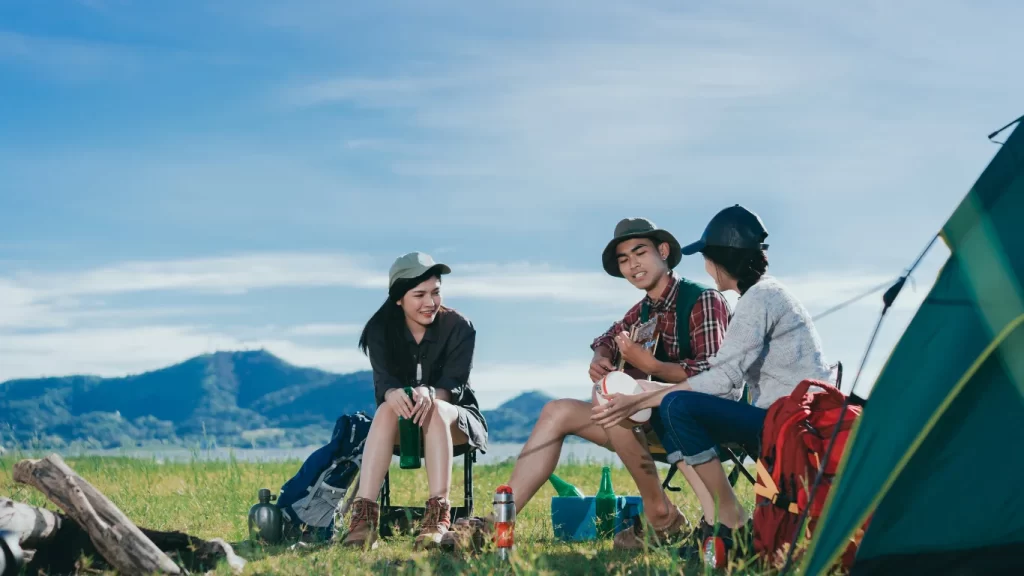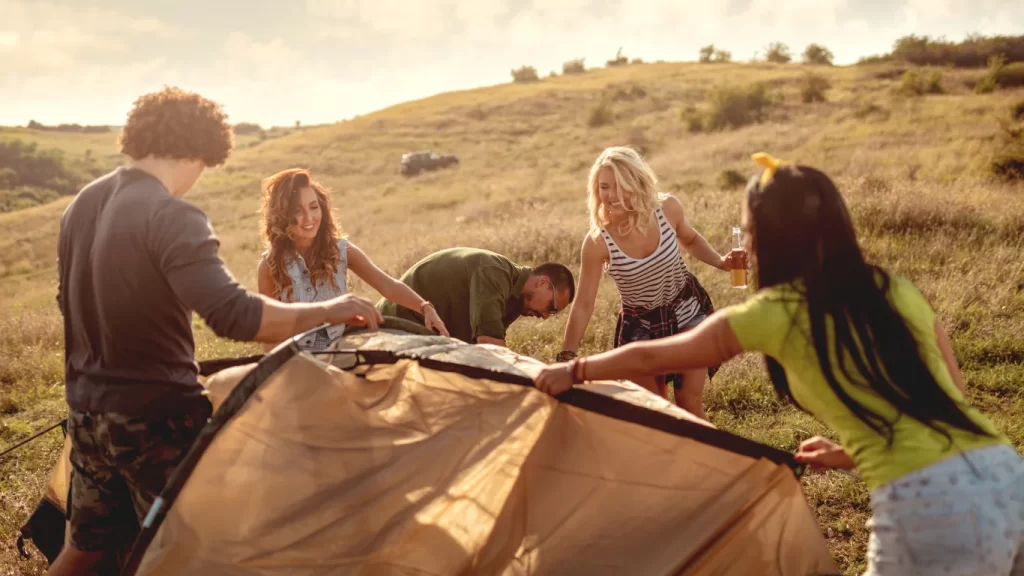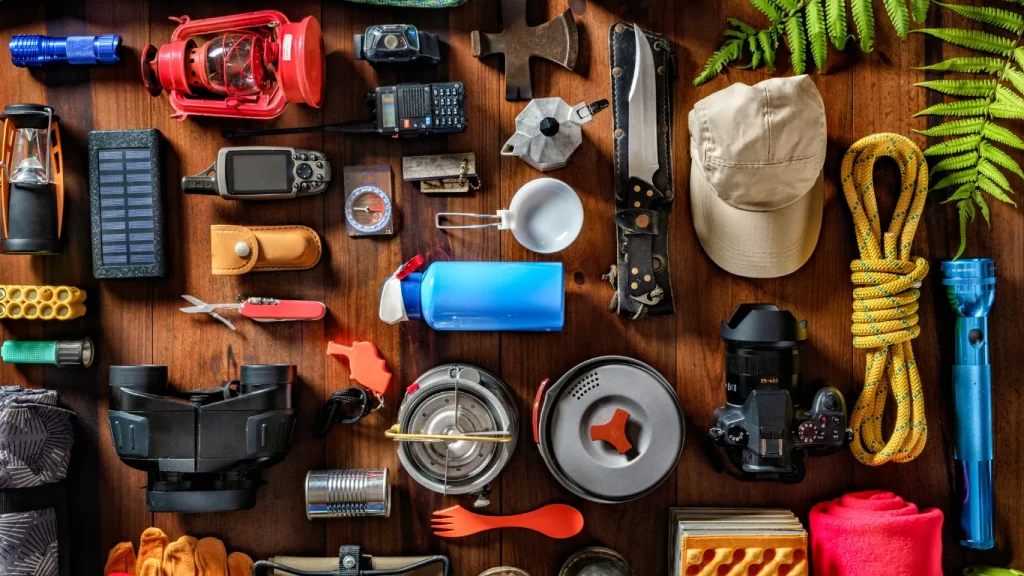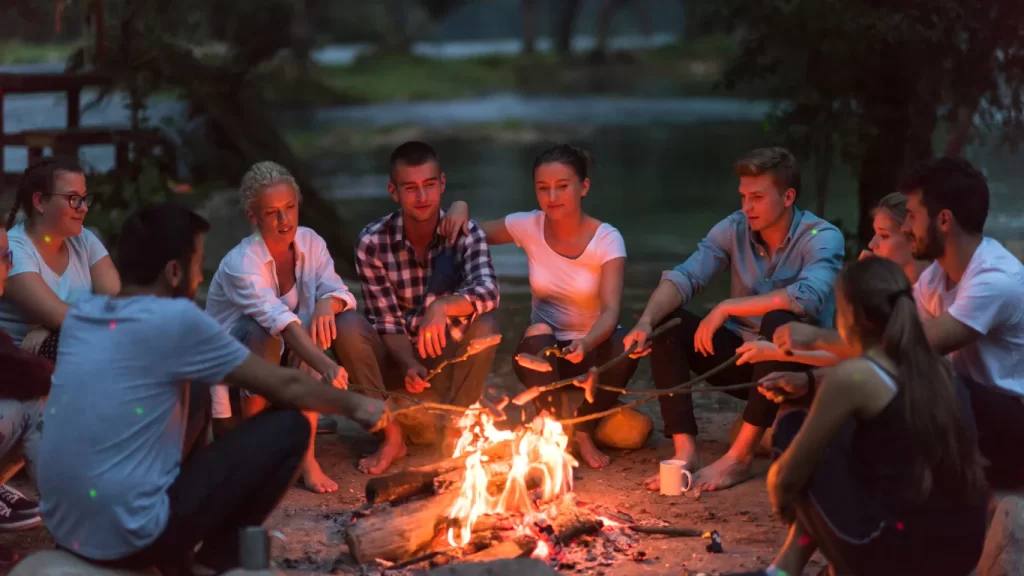Getting ready for a big camping trip is super exciting, and setting up your campsite just right is key to having a fantastic time in the great outdoors. This guide has all the expert advice you need on how to set up a campsite, whether you’re new to camping or looking to improve your skills. It covers everything from picking the perfect spot and setting up your tents to making sure you’ve got all the essential gear. Plus, there are some handy tips for staying safe around the campfire, keeping things clean, and organizing your site for maximum fun and comfort. So, get ready to make some fantastic camping memories!
Choosing the Right Are to Set up a Campsite
Selecting the appropriate campsite is crucial for both comfort and safety when venturing on a camping trip. This section will help guide beginners through the essential considerations when choosing a campsite, focusing on location and safety, environmental impact, and access to water and facilities.
Location and Safety Considerations

- Use Established Campsites: Opting for established campsites helps preserve the natural environment. These sites are designed to minimize the impact on the surrounding area, ensuring that the natural habitat is not disturbed. Avoid creating new paths or altering the landscape to fit camping needs.
- Safety from Natural Hazards: Ensure the campsite is safe from natural hazards. Avoid setting up near animal trails to prevent encounters with wildlife. Additionally, steer clear of low-lying areas that could flood during heavy rain. Check for overhanging branches or unstable terrain that could pose risks.
- Respect Wildlife and Water Sources: Campsites should be at least 50 meters away from water sources such as lakes, rivers, and streams to protect them from contamination. This distance helps preserve the water quality for both humans and wildlife.
Environmental Impact
Camping can significantly impact the local environment, affecting soil, vegetation, wildlife, and water systems. To mitigate these impacts:
- Minimize Ground Disturbance: Avoid actions that could lead to soil compaction and erosion, such as digging trenches or removing vegetation. Use existing trails and campsites to prevent the creation of new impacted areas.
- Wildlife Protection: Campers’ presence can disturb local wildlife. By using designated camping areas and keeping noise to a minimum, campers can lessen their impact on wildlife’s natural behaviours and habitats.
- Leave No Trace: Practice the ‘Leave No Trace’ principles by removing all trash and leaving the campsite as you find it. This includes scattering any moved rocks or leaves and ensuring that no waste is left behind.
Access to Water and Facilities
- Water Availability: Consider the availability of water sources for drinking, cooking, and cleaning. If relying on natural water sources, be prepared to treat water to make it safe for consumption. Avoid using soaps and chemicals near streams and lakes.
- Proximity to Toilets and Waste Disposal: Check if the campsite offers access to toilets. If not, be prepared to manage waste responsibly. Human waste should be buried in a small hole, at least 100 meters away from any water source, campsite, or trail, and all personal hygiene products must be packed out.
- Campsite Amenities: Some campsites offer additional amenities such as fire pits, picnic tables, and even hot showers. These facilities can significantly enhance the camping experience, especially for beginners.
By considering these factors, campers can choose a site that enhances their outdoor experience, protects the environment, and ensures their safety and comfort during their stay.
Setting Up Your Tent

When setting up your tent, it is essential to prepare the site, assemble the tent correctly, and consider weather and bug protection. Each of these steps is crucial in ensuring a comfortable and safe camping experience.
Site Preparation
- Choose Level Ground: Select an area that is level and clear of debris, such as rocks, branches, and protruding roots. This minimizes damage to the tent and enhances comfort when resting.
- Remove Obstacles: Clear the site of any twigs, rocks, or other debris. In areas with pine trees, spreading a thin layer of pine needles can soften the ground and improve sleeping.
- Consider Water Flow: Avoid setting up your tent in swales, divots, or hollows in the ground, as these areas can pool water during rain and potentially flood your tent.
- Use Natural Windbreaks: If it’s windy, use the natural tree line to create a windbreak. Position your tent closer to trees to block off some of the breeze.
- Avoid Hazardous Areas: Avoid dry river/creek beds and areas under trees that might drop branches or pose dangers during storms.
Tent Assembly Tips
- Layout the Tent and Accessories: Spread out the tent, poles, stakes, and any other accessories like a mallet. Ensure everything is accounted for before beginning assembly.
- Secure the Base: If necessary, stake down the base of the tent using a mallet. This prevents the tent from moving due to wind or during movement inside the tent.
- Assemble Poles and Frame: Connect the poles according to your tent’s instructions. These typically form the structural support of the tent and should be securely attached to the tent body.
- Raise the Tent: Attach the tent body to the assembled frame using hooks or sleeves as designated by your tent model. Ensure the structure is stable and upright.
- Attach Additional Accessories: If your tent comes with a rainfly or other accessories like lantern hooks or mesh gear lofts, attach these last. Ensure the rainfly is secured properly to keep the interior dry.
Weather and Bug Protection
- Position Away from Fire: To avoid smoke and reduce fire hazards, keep the tent entrance away from the campfire.
- Use a Ground Tarp: Lay a ground tarp right under the tent to prevent water from seeping in. Ensure the tarp is slightly smaller than the tent’s footprint to avoid collecting water.
- Secure the Rainfly: Attach and tighten the rainfly to protect against rain. Adjust it to ensure there is a gap between the rainfly and the tent to keep the interior dry.
- Bug Prevention: To create a bug-free environment, ensure all zippers on the tent door and windows are closed. If bugs are a concern in the area, consider using additional mosquito netting or a screen room.
- Check Weather Conditions: Be aware of all the weather conditions, such as fire bans, which might restrict the use of specific equipment, such as campfires or gas cookers.
By following these steps, campers can ensure their tent is set up safely and comfortably, ready to enjoy the camping experience.
Essential Gear and Supplies

Setting up a campsite requires careful consideration of the gear and supplies needed to ensure comfort, safety, and convenience. This section provides a detailed overview of the essential equipment for sleeping, cooking, and personal safety and care.
Sleeping Equipment
The quality of your sleep highly impacts your camping experience. Essential sleeping equipment includes a tent, sleeping bag, and sleeping pad, each tailored to the environment and season.
- Tent: Choose a sturdy tent suitable for the specific camping conditions, whether backpacking or car camping. It should be made from durable materials with adequate ventilation to prevent condensation and maintain airflow.
- Sleeping Bag: Select a sleeping bag suited for the lowest temperature you expect. High-quality insulation bags, such as down or synthetic fill, ensures warmth and comfort throughout the night.
- Sleeping Pad: A sleeping pad provides cushioning and insulation from the cold ground. Options include foam or inflatable pads with suitable R-values for the expected temperatures.
Cooking Gear
A reliable cooking setup enhances the camping experience by allowing you to prepare nutritious meals.
- Camping Stove: This is a must-have for cooking at the campsite. It offers a dependable cooking source, eliminating the need for open fires and providing a controlled cooking environment.
- Cooler: A cooler is essential for keeping perishables fresh, especially in warm weather. Choose a cooler with robust insulation to maintain a consistent temperature.
- Kitchen Utensils: Include durable and lightweight utensils such as spatulas, spoons, tongs, can openers, and knives. Opt for materials like stainless steel and plastic, which are practical for outdoor use.
- Food Storage Containers: Use pest-resistant, airtight containers to store food securely. Resealable, heavy-duty plastic bags are excellent for keeping food safe from bugs and moisture.
Safety and Personal Care Items
Personal protection and hygiene are crucial for a safe and enjoyable camping trip.
- Sun Protection: Always wear a wide-brimmed hat and sunglasses to protect against the sun’s rays. Use sunscreen with at least SPF 30 to be able to shield your skin from bad sunburn and long-term damage.
- Insect Repellent: An essential item to keep mosquitoes and ticks at bay, reducing the risk of vector-borne diseases. Opt for repellents containing DEET or Picaridin for effective protection.
- First Aid Kit: Pack a comprehensive first aid kit tailored to the duration of your trip and the number of people involved. Include items for treating minor injuries and allergies.
- Personal Hygiene: Bring items like wet wipes, hand sanitizer, and feminine wipes to maintain cleanliness when showers are not accessible. These are especially important in maintaining hygiene and comfort during extended outdoor stays.
By meticulously selecting and organizing these essential gear and supplies, campers can ensure a well-prepared, safe, and enjoyable outdoor adventure.
Campfire and Cooking Safety

Building a Safe Campfire
Safety is paramount when building a campfire, whether at a designated campsite or in the backcountry. To ensure a secure and enjoyable experience, follow these guidelines:
- Selecting the Campfire Spot: Always use established fire pits or rings when available. These are designed to contain fire safely and minimize environmental impact. If you are in a backcountry area where fires are permitted, use an existing ring if possible. Avoid areas with dry grasses, overhanging branches, or dense brush that could catch fire.
- Preparing the Fire Pit: Clear away flammable materials from around the fire pit. The base of your fire should be on non-organic material like mineral soil, gravel, or sand to prevent the sterilization of fertile soil.
- Gathering and Arranging Firewood: Collect only fallen wood and avoid cutting live or dead-standing trees, as these could be homes for wildlife. Organize your firewood into three types: tinder (small twigs, dry leaves), kindling (sticks smaller than 1 inch in diameter), and fuel (larger pieces of wood). Arrange the kindling over the tinder in a structure that promotes airflow, such as a teepee, lean-to, or log cabin formation.
- Lighting and Managing the Fire: Light the piece of tinder with a match or lighter and allow the flame to catch onto the kindling. Gradually, larger pieces of wood were added to build the fire. Always keep water, a bucket, and a shovel nearby to manage the fire and extinguish it if necessary. Keep the fire small and under control to prevent stray sparks.
- Extinguishing the Fire: Never leave your campfire unattended. Extinguish the fire by dousing it with water, stirring the ashes, and applying more water until the ashes are cool to the touch. Avoid using dirt or sand to extinguish fires as this can insulate hot coals, which might reignite later.
Food Storage and Preparation
Proper food storage and preparation are crucial to ensure safety and prevent wildlife encounters:
- Storage: Use bear-proof containers or hang food in a tree far away from your campsite to keep it out of reach of wildlife. Store all food, trash, and other scented items securely.
- Preparation: Prepare foods using clean utensils and surfaces. Keep raw and cooked foods separate and always wash your hands before and after handling food to avoid cross-contamination.
- Cooking: Be sure to cook all food to the appropriate temperatures to ensure safety. Remember to keep hot foods hot and also cold foods cold, and use a food thermometer to check that meat has reached the safe minimum internal temperature.
Water Management
Ensuring the safety of your water supply is essential while camping:
- Water Collection: When possible, collect water from flowing streams or rivers, as these are less likely to harbour pathogens than stagnant water. Avoid collecting water from areas near animal trails or downstream from other campsites.
- Water Treatment: Treat all collected water by boiling, using chemical treatments, or filtering it to remove pathogens. Boiling is the most reliable method, especially in survival situations.
- Hygiene: Always wash hands with soap and water before handling food and also after using the bathroom. If soap and water are not available, use a hand sanitizer containing with at least 60% alcohol.
By adhering to these practices, campers can enjoy a safe and worry-free experience regarding fire management, food safety, and water usage.
Maintaining Your Campsite
Maintaining a clean and orderly campsite is crucial for both environmental conservation and personal comfort. Here are essential practices to ensure your camping area remains pristine and minimally impactful throughout your stay.
Daily Routines for Cleanliness
- Pre-Camp Cleaning: Before arrival, ensure that tents and backpacks are free from crumbs and stains to avoid attracting pests. A thorough cleaning with a gear-specific cleaner like Nikwax Tech Wash is recommended.
- Establish Cleaning Rules: Set clear guidelines for your group regarding cleanup responsibilities. Stock up on necessary cleaning tools, reusable dishes, and bear-safe containers.
- Active Cleanup: Encourage cleaning as activities unfold, particularly before nightfall. This includes sweeping out the tent, clearing picnic areas with a broom, and ensuring all dishes are washed and stored immediately after meals.
- Waste Management: Utilize separate trash bags for food and non-food items. In bear-prone areas, secure food waste as stringently as the food itself to prevent wildlife encounters.
Gear Maintenance
- Post-Trip Cleaning: After each trip, clean your gear thoroughly. For tents, avoid machine washing; instead, spot clean and rinse with a hose. Sleeping bags should be cleaned as needed, based on usage frequency, to maintain insulation quality.
- Inspect and Repair: Regularly inspect gear for damage. Simple repairs, such as patching a tent or mending a sleeping bag, can be done at home, extending the life of the equipment.
- Proper Storage: Store all camping gear in a cool, dry place. Avoid compressing items like sleeping bags, which can damage their insulation. Use breathable storage bags or hang items where possible.
Leave No Trace Principles
- Plan Ahead and Prepare: Understand and implement the 7 Principles of “Leave No Trace” to always minimize your impact on the environment.
- Travel and Camp on Durable Surfaces: Make sure to use established sites and trails to reduce the degradation of untouched areas.
- Dispose of Waste Properly: All waste, including greywater and solids, should be disposed of correctly. Strain dishwater and use biodegradable soap to minimize site impact.
- Leave What You Find: Avoid altering sites or removing natural objects. Strive to leave the campsite better than you found it.
- Minimize Campfire Impacts: Use established rings for campfires and keep fires small. Ensure all wood is burned to ash and thoroughly extinguished.
- Respect Wildlife: Be sure to observe wildlife from a distance and store food securely to avoid altering their natural behaviours.
- Be Considerate of Other Visitors: Maintain low noise levels and keep your campsite visually unobtrusive to ensure an enjoyable experience for everyone.
By adhering to these guidelines, campers can enjoy their outdoor adventures while preserving the natural beauty of their surroundings for future visitors.
Conclusion
In this article, we’ve covered everything from choosing an excellent campsite to setting up tents and gathering the necessary gear and supplies for a successful camping trip. The advice we’ve provided focuses on the importance of preparation, safety, and being mindful of the environment. These factors are essential not only for making your outdoor adventure enjoyable but also for preserving the natural beauty of the outdoors that we all love to explore.
By following the principles and practices outlined here, such as ensuring campfire safety and maintaining the campsite properly, we all contribute to minimizing our environmental impact while camping. As you prepare for your next camping trip, remember that the beauty of the outdoors is something we all share. By being thoughtful in our preparations and committed to leaving no trace, we can help ensure that these natural wonders remain vibrant and accessible for generations to come.
FAQs
What are the essential steps for setting up a campsite?
To properly set up a campsite, start by selecting high, level ground free of stones, sticks, and debris. Place a tarp under your tent to protect it, and follow the tent assembly instructions carefully. Always attach your rainfly to the tent, use a sleeping pad for comfort, store food securely away from your sleeping area, and always dispose of your trash responsibly.
What are some tips for beginners setting up a camp?
Beginners should prioritize setting up shelter first. Choose a flat, clear area that offers shade, protection from wind, and good drainage. Store food in airtight containers far away from the sleeping area to keep it safe from wildlife and keep essential items within easy reach.
How can you ensure your camp setup is perfect?
For a perfect camp setup, find a level and debris-free spot. Ensure there’s ample space for your tent and gear. Set up a tarp or additional shelter for weather protection, and establish a fire ring for cooking and warmth.
What should be included in a camping checklist?
An essential camping checklist should include a camping tent with stakes and poles, a hiking pole, headlamps, an emergency whistle, a bear horn, a sleeping bag, a sleeping pad, a hammock, a camp cot, an insulated water cooler, an outdoor grill, moisture-wicking shirts, and a warm or shade hat.
How can I enhance my camping experience?
To elevate your camping experience, focus on comfort by investing in a quality tent and bringing essentials like a portable stove, a power supply, and a cooler. Plan your trip ahead, include a camping tarp for extra shelter, and always have a first aid kit ready.





